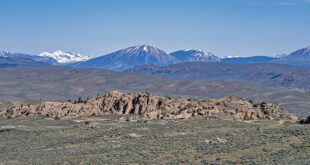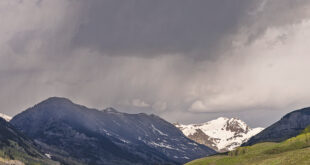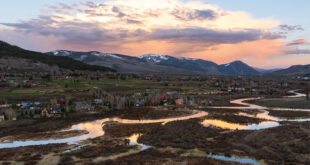An update on the local water planning situation
On or near the end of this month, Gunnison River Basin Roundtable chairman Michelle Pierce will sign off on a “Gunnison Basin Water Plan,” finishing a year of concentrated hard work by a dozen or so of the 32 basin roundtable members. This basin plan will then go the Colorado Water Conservation Board in Denver, along with eight other plans from other Colorado basin roundtables. Sometime around the end of the year, a single consolidated Colorado Water Plan will emerge to shepherd the use of the state’s water resources out to 2050.
Exactly what this consolidated Colorado Water Plan will look like is not known at this point—by anyone, I suspect. The usual cultural paranoia fills up the gap created by not knowing: metropolitan water users (about 80 percent of the population) fear the plan will impose draconian conservation measures on them in order to water the new growth (which will bring increased traffic and density pressures that already reduce their quality of life); East Slope farmers fear it will either outright redirect their water to the metropolis or will hatch a bunch of complex “water-sharing” schemes that will slowly erode their “property” in water; West Slope inhabitants (that’s us) fear it will include schemes to remove more water from the Upper Colorado River tributaries for the metropolis.
Realistically, the plan that emerges from the state will probably fulfill all of those fears to some extent. The planning process was undertaken when Colorado’s water leaders realized that, by mid-century, we are probably going to have another three to five million people in the state, all needing water from a finite, and possibly diminishing, water supply that is already stressed by people pressures. Because we humans are now a swarming species across the planet, and because large urbanized agglomerations of people are our current strategy for dealing with the swarm, most of the new people will coagulate in Colorado’s Front Range metropolis; and everything they will need, including water, will have to come from the “hinterlands” surrounding the metropolis (that’s us).
Hence, the need for a state water plan: how do we equitably distribute an already stressed but essential resource among maybe twice as many people—most of them concentrated in one water-short area? And since most of that resource is already being used to produce food—also something our swarm needs—how do we share the water without diminishing the food supply?
Finding water for new urban growth, mostly in the Front Range, is the challenge that precipitated this planning process. But the approach to planning decreed last year (May 2013) by Governor Hickenlooper took an unusual and roundabout route to addressing that specific problem. He mandated that the process would begin with each of the state’s nine basin roundtables drawing up a water plan to address its own internal needs and goals out to the mid-century horizon.
All nine basins, except for Colorado’s small part of the North Platte River, have discovered in their needs analyses that they themselves are probably going to be short of water to take care of their own anticipated municipal and industrial (M&I) growth.
The four West Slope basins (Yampa-White, Colorado, Gunnison and San Juan-Dolores) and the Rio Grande basin found that through a combination of small water projects, conservation programs, and “willing seller” agricultural transfers, they should be able to resolve their M&I shortages from within their own basins.
The two East Slope “natural” basins (South Platte and Arkansas) and the Metropolitan “Sink” (the non-basin encompassing Denver and its first and second ring of South Platte suburbs) found that—no surprise—they would need to find “new supply” from outside their basins in order to address their anticipated metropolitan growth. (The metro area spills well to the north and south of the formal “Metropolitan Basin.”) The annual metropolitan shortfall by mid-century is estimated at 200,000 to 600,000 acre-feet, depending on actual growth and the intensity and extent of demand-reduction programs. The Gunnison Basin M&I shortfall is about 1 percent of that. An acre-foot of water serves roughly two homes (with yards) for a year under current usage.
All of the “natural” basins have also quantified agricultural shortages—the difference between the water available and the “ideal” amount of water that would maximize the productivity of their land; these shortages added up to two million acre-feet statewide. Some of that is simply too much land under ditch for full irrigation, but a lot of the shortage could be reduced through irrigation infrastructure repair and efficiency, more small storage, et cetera.
None of the eight natural basins, however, has discovered in its planning process a couple to 300,000 acre-feet of unused water, thereby resolving the metropolitan gap, the basic problem that launched the whole planning process. That will have to be addressed in the state plan.
Where will the “new” metro water come from? There is a noticeable tendency in most of the state’s other basins to sing the old song to our great city: “It’s your misfortune and none of our own.” But there may be an element of both hypocrisy and bravado in that attitude. Hypocrisy because it requires that we conveniently forget what we learned in 2006 when a December blizzard shut down the Front Range—and suddenly our supermarkets were out of food.
Virtually everything we need to live well in this valley comes from or through entities based in Denver or some other terminal of the interchangeable “world city.” And it is bravado because having the law (water law) on your side is thin armor when the vast majority of the people don’t understand or feel served by that law; witness the tremor that runs through the water establishment every time some Front Ranger proposes a “public trust” initiative.
The bottom line there is that, like it or not, we hinterlanders need the Front Range as much as the Front Range needs hinterland water.
It is highly unlikely that there will be a significant transmountain diversion from the Upper Gunnison, especially since enactment of the Black Canyon decree and the reoperation of the Aspinall Unit for the endangered fish; but still, every gallon of water that goes to the Front Range from any West Slope stream decreases our local options under the terms of the Colorado River Compact.
The Gunnison Basin Water Plan addresses the “statewide” issue through some principles we hope the other West Slope basins will also put forward: stressing, first, the absence of any significant pool of water not already being used to the max intrabasin; and second, the high risk and high cost of very junior transmountain diversions that would only get any water at all in above-average water years.
While “pipedreams” like a several-hundred-mile pipeline from Flaming Gorge Reservoir in Utah to the Front Range continue to be raised, both Denver Water and the Municipal Subdistrict of Northern Water are currently setting the probable style for the future in trying to develop much more modest (and very expensive) expansions of existing diversions from the Upper Colorado tributaries in Grand County, which will only take West Slope water in “fat years” to be stored on the East Slope for the “lean years.” The Front Range cities are having a hard time facing the fact that most of the “new supply” they cannot get through upfront demand reduction, conservation and reuse will not be from magnificent dams and tunnels, but is going to have to come through creative arrangements with agricultural users that will, it is hoped, not significantly reduce the land in agriculture. To paraphrase Willie Sutton: That’s where the water is.
The core or heart of each basin plan is the list of projects, programs and processes for meeting its own needs, addressing its own goals; the Gunnison Basin plan lists over 100. Working through those lists will undoubtedly require some 20th-century-style concrete projects for physically moving water around, although affordability will be a huge issue there. But a lot of the harder work will be “programs and processes” for “moving our minds around” on how a swarming population can reasonably and equitably share out a finite and already mostly developed resource. If we are going to have up to twice as many people, trying to live modern lives with the same (or a climate-reduced) water supply, we are going to be living in a different West by mid-century.
To see the Gunnison Basin Water Plan (or any other basin’s), go to www.coloradowaterplan.com, and click on “Community” in the top menu. There are tracks on that website for submitting your own input on the planning process—but you may also send it directly to Gunnison Basin Plan chairman Frank Kugel, fkugel@ugrwcd.org, or give this correspondent a call at 641-4340.
(Opinions expressed in this article are those of the writer only, and may not reflect the consensus of the Gunnison Basin Roundtable.)
–George Sibley
(George Sibley has been writing about water since his years as editor of the Crested Butte Chronicle in the late 1960s, albeit from an increasingly more informed position. He is currently immersed in water issues with the Upper Gunnison River Water Conservancy District and the Gunnison Basin Roundtable.)
 The Crested Butte News Serving the Gunnison Valley since 1999
The Crested Butte News Serving the Gunnison Valley since 1999





